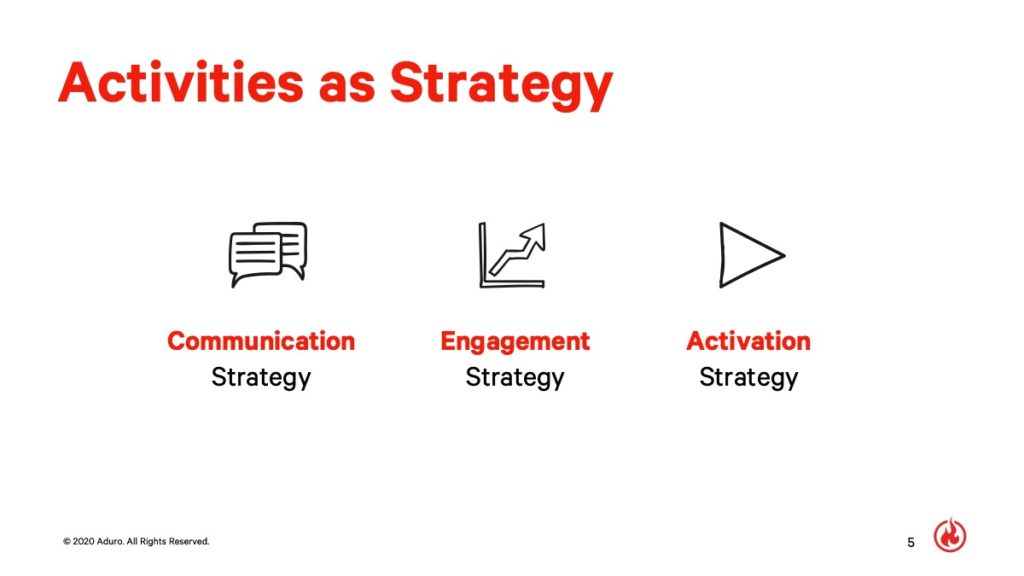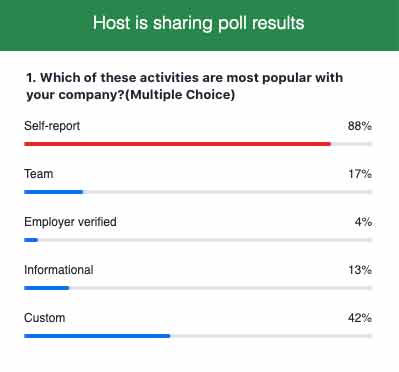Driving wellness program engagement is often a pain-point for employee benefits managers. Traditional wellness programs offer stale, boring activities that don’t offer individualized or holistic options to support the goals of employees. Aduro tackles this issue head-on with relevant and engaging activities that support all aspects of a person’s life – driving higher utilization and excitement towards the well-being program – with very little effort from the Human Resources department to manage.
Well-being Program Activities
Program activities are those quick snack-size engagement tools inside of a corporate wellness program with a purpose to encourage deeper engagement of healthy wellness habits and practices. At Aduro, our well-being program activities are closely tied to driving engagement in our more involved digital coaching and content. We do this through our proprietary software Aduro Connect™.
Aduro Connect is a web and app-based platform where members have access to a library of content and resources that they can discover and engage with to support all aspects of their well-being and mental health. Learn more about our solutions.
Program activities, often referred to as wellness challenges, are usually the first item our members engage with on Aduro Connect. It’s extremely important to strategically think about how activities are utilized throughout the program year. Activities can be used in three ways as part of your overall engagement strategy.
3 Ways to Strategically Use Program Activities

- Communication: activities can serve as a valuable way to inform your employees about important company initiatives and benefits available to them.
- Engagement: activities can provide a learning opportunity for employees in an easily consumed format.
- Activation: activities can drive deeper engagement into other aspects of your well-being program like habit-change and lifestyle coaching.
LEAP Framework
Aduro has adopted a LEAP (Listen, Engage, Activate, and Predict) framework in designing program strategy with our clients. This framework further develops our utilization of program activities to increase program success.
Listen. Using a variety of different active and passive collection tools, we can build out a unique Human Performance profile for each member. This gives the member and our coaches information to ignite positive change. Our Listen Tools include biometric screening data, Human Performance Assessment (HPA) results, integrated device and app data, and profile information.
Engage. Once we have data available from our members, we can begin to support their progress toward goals through gentle reminders, nudges, daily check-ins and other methods – all determined by each individual member to support their communication styles.
Activate. Through insights, expert coaching, interactive content, and relevant activities, our members have a streamlined experience all in one place, personalized according to their goals and needs.
Predict. Through an ongoing measurement strategy, Aduro Connect can continually drive action by providing members with a greater understanding of where they’ve come from and where they need to go to reach their full potential. All of these insights are also provided at an aggregate data level to employers to help assess the health, well-being and mental health of their organization. Through these insights, organizations can take steps to improve their overall population by building strategies to support the needs of their people.
Learn more about our LEAP Framework and the Principles of Human Performance in our eBook, Bringing Humanity Back to the Workplace.
4 Types of Well-being Program Activities
There are multiple ways activities can be setup throughout the year inside of an Aduro Human Performance program.
- Self-reported: a program activity where individuals can track and earn points at an individual level.
- Team activities: a program activity where a group of individuals join and work together toward a common goal to complete it. A common example of this is a step challenge – where a group is working towards an end goal of a certain number of steps. 3.1 million steps may seem like a lot, but when working as a group, it becomes something that can be accomplished and can build morale around a shared goal.
- Employer verified: a program activity where completion must be verified by the employer in order for completion and points to be awarded to the member. Often these activities are related to benefits-related requirements. At Aduro, we use these activities internally often for company-wide training sessions. We also offer the ability to integrate with other vendors to provide verification of activity completion.
- Informational: a program activity that is not worth any points but acts as a place for employees to find important company resources. These activities stay visible within the well-being program through-out the year and do not require a completion action. Common examples are links to medical and dental benefits or an available Employee Assistance Program (EAP).
Knowing what types of activities are best for your program
Our philosophy at Aduro is to offer a flexible program for your employees utilizing the key principles of Human Performance. By building an activity strategy with a mixture of all of these activity types, your program will be more inclusive and welcoming to participants of your well-being program.
The 5 Key Principles of Human Performance
- It’s for everyone
- It addresses the whole person
- It’s individualized and authentic
- It’s scientifically based on motivation and behavior change
- It’s performance-driven
And as we think about program activities, it important to keep these principles in mind to assure they are holistic and inclusive.
In a recent survey of Aduro clients, the highest utilized activity type (88%) was self-reported. Referencing the Key Principles of Human Performance, self-reported activities offer individualized, holistic options for every participant, regardless of their goals.

Another important factor to keep in mind when developing your activity strategy is connecting everything back to your goals. If the main goal of your well-being program is to better support the mental health of your employees, there must be impactful activities available for your employees that not only offers support and resources but drives them to take action with more involved aspects of the program like digital content or one-on-one coaching.
Keeping Activities Relevant and Engaging
Something that differentiates Aduro from other corporate wellness vendors is our in-house Content and Media Labs team. They continually work to develop scientifically based content that is up-to-date and relevant inside of activities and digital coaching. Learn more about Aduro’s content strategy in our latest webinar: Elevate Your Employee Wellness Program through Meaningful Content.
Developing a strategy around what types of activities you offer employees and how they can activate individuals to take the next steps is critical to well-being program success. Through our Human Performance approach to supporting all aspects of an employee’s life, our Client Experience team develops a strategy with our clients to support the overall goals of the organization. Discover how we can bring this strategy to your organization and take your wellness program to the next level, helping your employees reach their full potential.

